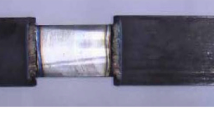Abstract
The ductility-dip cracking (DDC) susceptibility of high-chromium, nickel-base filler metals was evaluated using the strain-to-fracture (STF) test technique. These filler metals were of the Ni-30Cr type and included INCONEL® Filler Metals 52 and 52M supplied by Special Metals Welding Products Company, and Sanicro 68HP® and Sanicro 69HP® supplied by Sandvik AB. In addition, two experimental Ni-30Cr filler metals were evaluated which contained variations in other alloy additions including Nb above 1 wt % and Mo up to 4 wt %. A wide range in DDC susceptibility was observed with these filler metals, including large heat-to-heat variations in filler metals with similar compositions. The experimental filler metals were found to be remarkably resistant to DDC. Cracking susceptibility is primarily associated with the type and form of precipitate that forms along the weld metal migrated grain boundaries. The formation of Nb-rich, M(C, N) at the end of solidification has the most profound effect on DDC, since these precipitates are most effective in pinning the boundaries. The formation of M23C6 carbides during weld cooling or subsequent reheating can also affect DDC susceptibility in these filler metals.
Similar content being viewed by others
References
Ramirez A.J., Lippold J.C.: High temperature behavior of Ni-base weld metal, Part I, Ductility and microstructural characterization, Materials Science and Engineering A, 2004, 380, pp. 259–271.
Ramirez A.J., Lippold J.C.: High Temperature behavior of Ni-base Weld Metal, Part II, Insight into the mechanism for ductility dip cracking, Materials Science and Engineering A, 2004, 380, pp. 245–258.
Nissley N.E., Lippold J.C.: Development of the strain-to-fracture test for evaluating ductility-dip cracking in austenitic alloys, Welding Journal, 2003, 82, 12, pp. 355s–364s.
Lippold J.C., Nissley N.E., Ramirez A.J.: Recent advances in the understanding of ductility-dip cracking, IIW-IX-2161–05, Prague, July 11–14, 2005.
Collins M.G., Lippold J.C.: An investigation of ductility-dip cracking in Ni-base filler metals-Part 1, Welding Journal, 2003, 82, 10, pp. 288s–295s.
Lippold J.C., Ramirez A.J.: Insight into the mechanism of ductility dip cracking, IIW-IX-2123–04, July 2004, Osaka, Japan.
Author information
Authors and Affiliations
Rights and permissions
About this article
Cite this article
Lippold, J.C., Nissley, N.E. Further Investigations of Ductility-Dip Cracking in High Chromium, Ni-Base Filler Metals. Weld World 51, 24–30 (2007). https://doi.org/10.1007/BF03266597
Published:
Issue Date:
DOI: https://doi.org/10.1007/BF03266597




